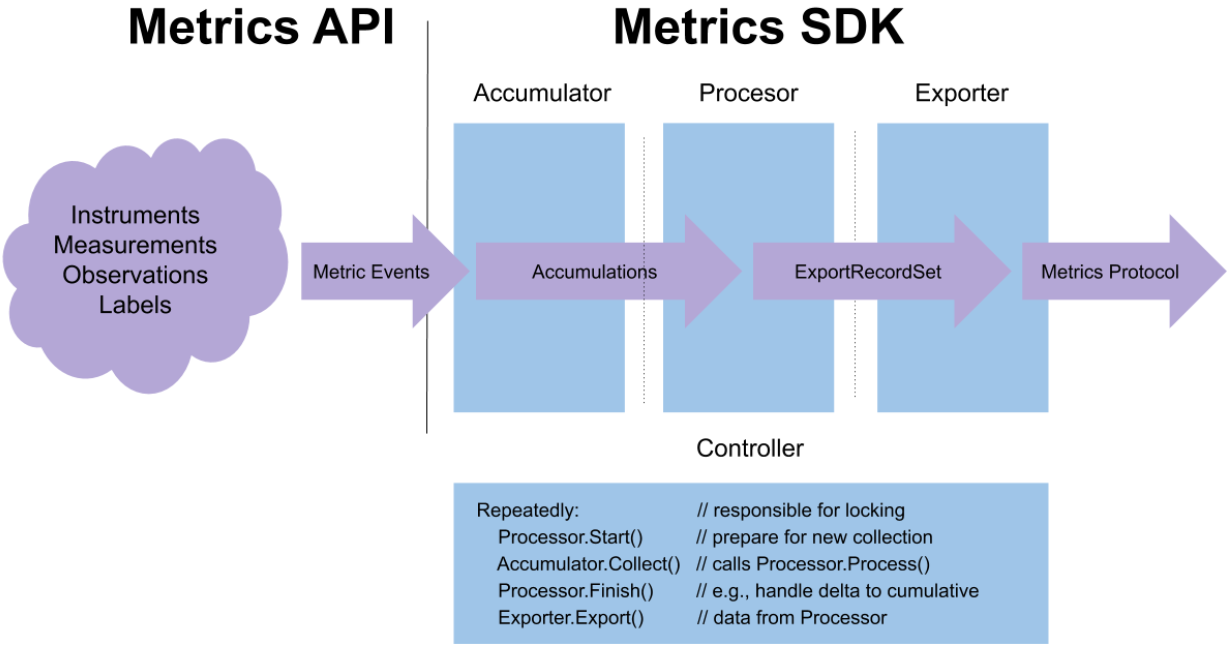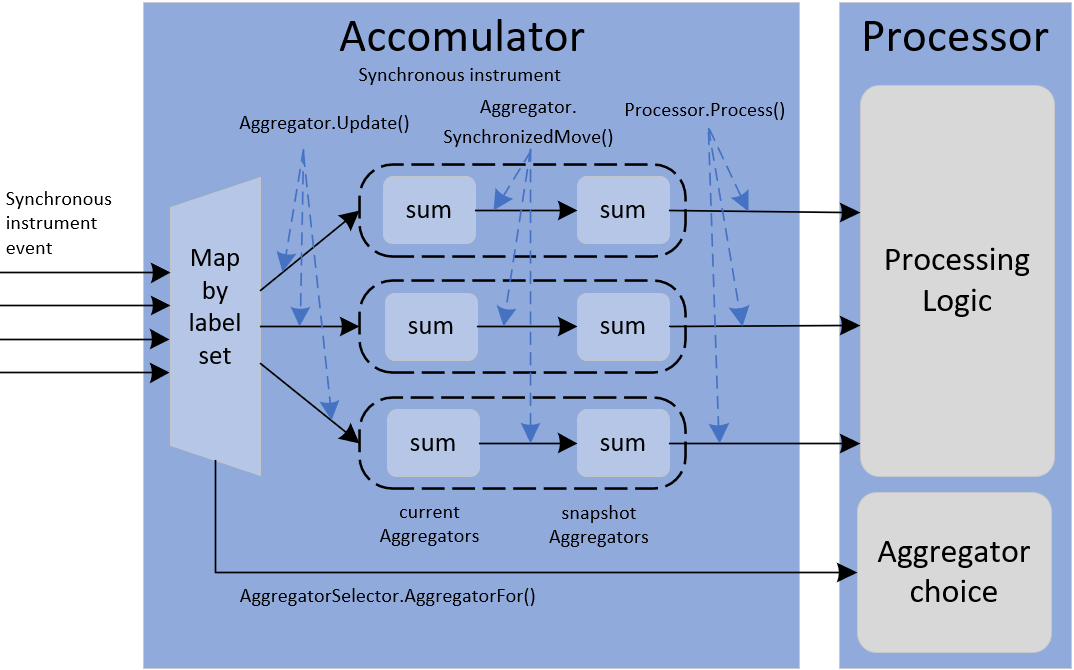Metrics SDK
目标
本文档包含两个部分,在第一部分中列出了实现OpenTelemetry Metric SDK的默认需求。实现者需要根据这些规则来实现OpenTelemetry API。
在第二部分中,以OpenTelemetry-Go Metric SDK为例描述了SDK模型的架构细节,给出所需要实现的内容,以此作为对实现者的指导,而不需要强制跨语言精确地去复制这种模型体系结构。
期望
SDK实现者在实现OpenTelemetry API时应该遵守该语言的最佳实践和运行时环境。实现者应该遵循 OpenTelemetry library guidelines给出的有关安全和性能的规定。
SDK 术语
Metrics SDK提供了一种Metrics API的实现,包含如下术语(本文后续将直接采用如下术语,不作翻译):
- Meter:支持OpenTelemetry Metric API的接口,与Resources 和Instrumentation Library绑定在一起
- MeterProvider:通过给定的Instrumentation Library获取Meter实例的接口
这些术语用于描述API和SDK的边界,但它们都是API级别的结构。我们可以使用API级别的术语来描述SDK和API之间的边界,但从API的角度看,SDK是不透明的,且没有结构。
本文给出了默认OpenTelemetry SDK的主要组件的内部结构,通过术语来解释每个组件在将metric数据从输入(API级别的事件)导出到输出(metric呈现格式)中所扮演的角色。我们使用Export Pipeline来描述SDK级别的功能。
export pipeline中有三个数据流会经过的主要组件,按顺序为:
- Accumulator:接收API通过Instrument获取的metric事件,并根据活动的Instrument和Label Set对计算出一个Accumulation
- Processor:从Accumulator接收Accumulations ,并转换为ExportRecordSet
- Exporter:接收ExportRecordSet,并转换为某种协议(如grpc),将其发送出去
Controller 组件在export pipeline中协调Accumulator、Processor和Exporter。
Metrics API规范定义了如下术语:
- Metric Instrument:开发者用于操作工具的API对象
- Synchronous Instrument:用户通过应用程序上下文调用的metric Instrument
- Asynchronous Instrument:通过从SDK的回调调用的metric Instrument
- Metric Descriptor:描述一个metric Instrument
- Metric Event:单个记录到或观察到的(Instrument, Label Set, Measurement)
- Collection Interval: Accumulator.Collect()调用的周期
- Label: 描述metric Event属性的key-value
- Label Set: 包含唯一的keys的key-values集
- Measurement: 来自synchronous instrument的证书或浮点数
- Observation: 来自asynchronous instrument的证书或浮点数
Resource SDK 定义了如下术语:
- Resource: 描述进程的一组具有唯一keys的key-value集
- Instrumentation Library:与一个工具包关联的名称和版本
下面为架构中重要的数据类型:
- Aggregator: 以一种有用的方式汇总一个或多个measurements
- Aggregator Snapshot: 在采集期间拷贝synchronous instrument aggregator的副本
- AggregatorSelector: 选择分配给metric instrument 的Aggregator
- Accumulation: 包含Instrument, Label Set, Resource, 和Aggregator snapshot, 由Accumulator生成
- Aggregation: 由特定的aggregator聚合一个或多个事件产生的结果, 由Processor生成
- AggregationKind: 描述了Aggregation支持的API类型 (e.g., Sum)
- ExportKind: Delta, Cumulative, 或Pass-Through的一种
- ExportKindSelector: 为一个metric Instrument选择ExportKind
- ExportRecord: 包含Instrument, Label Set, Resource, Timestamp(s), 和Aggregation
- ExportRecordSet: 一些列的export records.
术语SDK instrument 指Instrument的底层实现。
数据流图表
从外部看, Metrics SDK 实现了Meter 和MeterProvider接口,从内部看, Metrics SDK为每个metric数据封装了一个export pipeline,包含四个重要组件。

Accumulator组件是将metric event并发地传递给Aggregator的地方,这是负责SDK性能的组件。Accumulator 负责bound 和unbound Instrument,更新和同步拷贝Aggregator 状态,调用Observer Instrument以及唤醒采集周期。
Processor 组件是exporter pipeline中可定制的组件。Processor 负责通过一个独立的AggregationSelector接口为特定的Instrument选择Aggregators ,用于减少维数,以及用于在DELTA和CUMULATIVE数据表示之间进行转换。Processor 接口支持任意协议独立的数据转换,且可以将Processor连接在一起,形成更复杂的export pipelines。
Exporter 组件将处理的数据转换为特定的协议,并将其转发到某处。根据 library guidelines,exporter应该包含最小的功能,定制时最好通过Processors来表示。
Controller 组件协调在一个采集间隔内的采集动作,处理和导出采集间隔内的metric数据,确保对export pipeline的访问是同步的。
要求
下面列出了针对OpenTelemetry SDK主要组件的要求。
上面展示了一个抽象的数据流图,将本文档使用的标准组件名与数据路径做了映射。上图并非要说明SDK的整体架构,仅命名了一个export pipeline的过程,并将组件放到了上下文中。
SDK要求这些组件使用标准名称,这样做有助于在OpenTelemetry中构建一致性。每个SDK都应该包含这些组件,以及下面列出的接口,尽管每个SDK的实际组织可能会因可用的库和源语言的性能特征而有所不同。例如,一个SDK可能为每个instrument实现了一个Accumulator,或者可以为每个采集周期使用一个Accumulator(假设支持多采集周期)。
SDK
SDK封装了OpenTelemetry Metric export pipeline,实现了Meter接口,并管理SDK instrument,Resource和Instrumentation Library 元数据。
MeterProvider
Shutdown
该方法为provider提供了一种清理环境的方法。
每个MeterProvider实例只能调用一次Shutdown,在调用Shutdown之后,将不允许获得Meter。对于这些调用,SDK应该返回一个有效的无操作Meter。
Shutdown应该提供一种方式来让调用者知道是否成功,失败或超时。
当出现超时时,Shutdown应该结束或中止。Shutdown可以被实现为一个阻塞API,或异步API,通过回调或事件通知调用者。语言库作者可以决定是否配置shutdown的超时时间。
SDK:Instrument注册
OpenTelemetry SDK负责确保单个Meter的实现不会报告具有相同名称但不同定义的多个Instrument。为了实现该要求,如果一个Meter已经注册了一个相同名称的metric,则SDK必须拒绝在该Meter重复注册该Instrument。该要求甚至适用于尝试注册一个具有相同定义的Instrument。我们假设单个instrumentation library可以使用单个Instrument定义,而不是依赖SDK的重复注册。
不同的Meter具有不同的instrumentation library名称,允许在不同的instrumentation library中注册相同名称的Instrument,这种情况下,SDK必须将它们认为是不同的Instruments。
SDK负责实现API规范中包含的metric名称的语法要求。
SDK: RecordBatch() 函数
TODO: Add functional requirements for RecordBatch().
SDK: Collect() 函数
SDK负责实现Collect()函数,该函数会调用一个或多个Accumulators。本规范刻意避免在SDK和Accumulator之间建立特定关系;还有一个实现细节,即一个SDK是否会维护一个Accumulator,或每个Instrument对应一个Accumulator,或介于两者之间的某些配置。
SDK Collect()函数必须通过活动的synchronous instruments以及所有注册的asynchronous instruments的Accumulations来调用Processor。
SDK必须允许在评估asynchronous instrument回调期间使用synchronous metric instruments。但通过asynchronous instrument回调来使用synchronous instruments是有副作用的,这种情况下,SDK应该在处理asynchronous instrument之后再处理synchronous instruments,这样synchronous measurements会作为asynchronous observations采集间隔的一部分进行处理。
Accumulator
下图展示了API和Accumulator之间的关系,以及synchronous instruments的细节。

对于一个synchronous instrument,Accumulator会:
- 将每个活动的Label Set 映射到一条记录中,该记录由两个相同类型的Aggregator实例组成
- 在映射中输入新记录,如果需要,调用AggregationSelector
- 更新当前的Aggregator 实例,用以响应并发API事件
- 在当前Aggregator 实例上调用Aggregator.SynchronizedMove:a)拷贝其值到Aggregator快照实例中;b)将当前的Aggregator重置为0状态
- 调用Processor.Process。处理每一个生成的Accumulation (即Instrument, Label Set, Resource, 和Aggregator snapshot)
Accumulator必须提供选项来将一个Resource与它生成的Accumulations进行关联。
Synchronous metric instruments可以同步使用,除非源语言不支持该特性。SDK Accumulator 组件应该注意同步产生的性能压力。
Accumulator可能会使用排他锁定来维护synchronous instruments的更新。在调用Aggregator 时,Accumulator不应该持有排他锁,因为Aggregators可能具有更高的同步期望。
Accumulator: Collect()函数
Accumulator必须实现Collect方法来为活动的instruments构建和处理当前的Accumulation值,即在上一次采集之后会更新这些值。Collect方法必须调用Processor来处理对应调用之前的所有metric events的Accumulations。
必须在Collect期间使用Aggregator上的同步移动操作来计算Accumulations。该操作会同步拷贝当前的Aggregator,并将其重置为0状态,这样Aggregator会在当前采集周期处理结束之后,下次采集周期开始时立即开始累加事件。一个Accumulation 定义为同步拷贝的Aggregator与Label Set, Resource, 和metric Descriptor的组合。
TODO: Are there more Accumulator functional requirements?
Processor
TODO Processor functional requirements
Controller
TODO Controller functional requirements
Aggregator
TODO Aggregator functional requirements
如果可能的话,Sum Aggregator应该使用原子操作。
模型实现
本模型实现基于OpenTelemetry-Go SDK,本节为实现者提供指南。
Accumulator: Meter实现
为了构造一个Accumulator,需要提供Processor和options
// NewAccumulator constructs a new Accumulator for the given
// Processor and options.
func NewAccumulator(processor export.Processor, opts ...Option) *Accumulator
// WithResource sets the Resource configuration option of a Config.
func WithResource(res *resource.Resource) Option
Controller会使用Collect()方法来调用Accumulator,对采集进行协调。
// Collect traverses the list of active instruments and exports
// data. Collect() may not be called concurrently.
//
// During the collection pass, the Processor will receive
// one Process(Accumulation) call per current aggregation.
//
// Returns the number of accumulations that were exported.
func (m *Accumulator) Collect(ctx context.Context) int
实现与用户级别的Metric API匹配的SDK级别的API
该接口位于SDK和API的边界处,包含3个方法:
// MeterImpl is the interface an SDK must implement to supply a Meter
// implementation.
type MeterImpl interface {
// RecordBatch atomically records a batch of measurements.
RecordBatch(context.Context, []label.KeyValue, ...Measurement)
// NewSyncInstrument returns a newly constructed
// synchronous instrument implementation or an error, should
// one occur.
NewSyncInstrument(descriptor Descriptor) (SyncImpl, error)
// NewAsyncInstrument returns a newly constructed
// asynchronous instrument implementation or an error, should
// one occur.
NewAsyncInstrument(
descriptor Descriptor,
runner AsyncRunner,
) (AsyncImpl, error)
}
这些方法覆盖了实现OpenTelemetry Metric API所需的所有入口。
RecordBatch是一个直接由Accumulator实现的用户级别的API。另外两个instrument构造器用于创建同步和异步SDK instruments。
用户通常对Metric API Meter 接口感兴趣,该接口通过Metric API MeterProvider 接口获得。可以通过封装SDK Meter实现来构建Meter接口。
// WrapMeterImpl constructs a named `Meter` implementation from a
// `MeterImpl` implementation. The `instrumentationName` is the
// name of the instrumentation library.
func WrapMeterImpl(impl MeterImpl, instrumentationName string, opts ...MeterOption) Meter
该方法的选项:
- 可以为命名的Meter添加instrumentation library版本
instrument注册:
// NewUniqueInstrumentMeterImpl returns a wrapped metric.MeterImpl with
// the addition of uniqueness checking.
func NewUniqueInstrumentMeterImpl(impl metric.MeterImpl) metric.MeterImpl {
访问instrument descriptor
API Descriptor 方法根据API级别的构造定义了instrument ,包括名称,instrument类型,描述和度量单位。在实现SDK时必须提供方式来访问传递给constructor的Descriptor。
// InstrumentImpl is a common interface for synchronous and
// asynchronous instruments.
type InstrumentImpl interface {
// Descriptor returns a copy of the instrument's Descriptor.
Descriptor() Descriptor
}
Synchronous SDK instrument
Synchronous SDK instrument 支持直接和绑定调用规范。
// SyncImpl is the implementation-level interface to a generic
// synchronous instrument (e.g., ValueRecorder and Counter instruments).
type SyncImpl interface {
// InstrumentImpl provides Descriptor().
InstrumentImpl
// Bind creates an implementation-level bound instrument,
// binding a label set with this instrument implementation.
Bind(labels []label.KeyValue) BoundSyncImpl
// RecordOne captures a single synchronous metric event.
RecordOne(ctx context.Context, number Number, labels []label.KeyValue)
}
// BoundSyncImpl is the implementation-level interface to a
// generic bound synchronous instrument
type BoundSyncImpl interface {
// RecordOne captures a single synchronous metric event.
RecordOne(ctx context.Context, number Number)
// Unbind frees the resources associated with this bound instrument.
Unbind()
}
Asynchronous SDK instrument
Asynchronous SDK instrument 支持单观察者和匹配观测者调用规范。用于执行Observer回调的接口会传递给constructor,这样asynchronous instruments就不需要其他API级别的访问方法。
// AsyncImpl is an implementation-level interface to an
// asynchronous instrument (e.g., Observer instruments).
type AsyncImpl interface {
// InstrumentImpl provides Descriptor().
InstrumentImpl
}
传递给asynchronous SDK instrument constructor 的异步"runner"接口(AsyncRunner)同时支持单个和批量调用规范。
Export pipeline细节
TODO: define AggregatorSelector, Aggregator, Accumulation, ExportKind, ExportKindSelector, Aggregation, AggregationKind ExportRecord, ExportRecordSet
Processor细节
TODO: define the Processor interface
Basic Processor
TODO: define how ExportKind conversion works (delta->cumulative required, cumulative->delta optional), Memory option (to not forget prior collection state).
Reducing Processor
TODO: Label filter, LabelFilterSelector
Controller 细节
TODO: Push, Pull
Aggregator Implementations
TODO: Sum, LastValue, Histogram, MinMaxSumCount, Exact, and Sketch.
Pending issues
ValueRecorder instrument default aggregation
TODO: The default SDK behavior for ValueRecorder instruments is still in question. Options are: LastValue, Histogram, MinMaxSumCount, and Sketch.
Spec issue 636 OTEP 117 OTEP 118
Standard sketch histogram aggregation
TODO: T.B.D.: DDSketch considered a good choice for ValueRecorder instrument default aggregation.